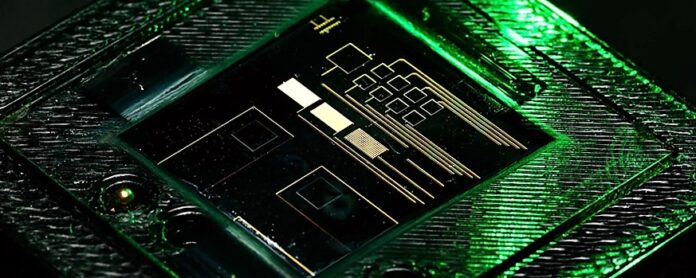Unveiling a Groundbreaking Innovation
In a feat defying conventional expectations, engineers have unveiled an extraordinary light sensor boasting an astonishing efficiency of 200%. By harnessing the intricate principles of quantum physics, they have pushed the boundaries of what was once deemed impossible. Termed the photodiode, this highly sensitive sensor holds immense promise for non-intrusive monitoring of vital signs, charting a new course in the realm of advanced technology.
Diving into Photodiode Efficiency Dynamics
The efficiency of a photodiode hinges upon its remarkable ability to transform light particles into electrical signals. Delving deeper into this realm, researchers have directed their focus towards a specific facet known as photoelectron yield. This concept revolves around the sheer number of electrons generated when photons collide with the sensor. Quantum efficiency, which constitutes the material’s intrinsic capability to generate charge-carrying particles, emerges as a pivotal factor governing the photoelectron yield phenomenon.
Achieving Unprecedented Efficiency Levels
Setting out on an audacious endeavor, scientists embarked upon a journey to combine the prowess of two distinct solar panel cells: perovskite and organic. This amalgamation birthed a revolutionary hybrid device, wherein stacked cells adroitly captured errant light that evaded a single layer. Consequently, the quantum efficiency soared to an impressive 70%. However, the researchers’ unwavering pursuit for enhanced efficiency didn’t halt there. They introduced a supplementary dose of green light, meticulously optimizing the sensor to effectively filter various light types and perform impeccably even in the absence of light. These meticulous refinements culminated in the creation of a photodiode showcasing a quantum efficiency that transcended the 200% threshold, confounding the scientific community with its remarkable performance. Yet, the precise mechanisms that propel this unprecedented surge in efficiency remain shrouded in mystery, beckoning further exploration and inquiry.
Decoding the Role of Photodiode Current
To unravel the enigmatic workings of the photodiode, it is crucial to comprehend the intricate dance between photons and electrons within the sensor’s material. When photons collide with the photodiode material, they stimulate electrons, setting them into motion and causing them to amass charge. The researchers postulate that the introduction of green light initiates an accumulation of electrons within the perovskite layer, serving as a reservoir of potential. When infrared photons are absorbed by the organic layer, these electrons are unleashed, bringing forth an astonishing efficiency of 200% or beyond. Each infrared photon that generates an electron seamlessly begets an additional electron, fueling this electrifying phenomenon and opening up new vistas of scientific understanding.
Revolutionizing Vital Sign Monitoring Applications
With heightened efficiency comes unparalleled sensitivity, enabling the photodiode to discern minuscule fluctuations in light emanating from considerable distances. This extraordinary sensitivity paves the way for monitoring vital signs, such as heart rate and respiration, without necessitating physical contact. Embarking on this transformative path, the researchers deployed their ultra-thin photodiode, boasting a slimness that rivals even the thinnest newspaper. Astonishingly, they successfully captured and measured subtle changes in infrared light reflected from a finger positioned a staggering 130 centimeters (51.2 inches) away. The gathered data exhibited strong correlations with blood pressure and heart rate, akin to the functionality of a cutting-edge smartwatch sensor, yet transcending limitations by operating remotely.
The researchers further demonstrated the photodiode’s remarkable potential in measuring respiration rates by sensitively detecting minute chest movements. This groundbreaking technology holds profound implications for a myriad of medical monitoring applications, paving the way for a future where healthcare can be revolutionized. However, it is important to note that while this achievement is undoubtedly remarkable, further development and refinement beyond the laboratory setting are imperative to fully unlock the potential of this breakthrough technology.
Moving forward, the researchers are unwavering in their commitment to advancing the capabilities of the photodiode. Their primary objective lies in improving the device’s speed, aiming for seamless and real-time data acquisition. By enhancing its responsiveness, the photodiode can further solidify its position as a game-changer in the field of vital sign monitoring.
Moreover, the researchers are driven by the desire to explore avenues for clinical testing. While the photodiode has showcased immense promise within controlled environments, rigorous testing in real-world scenarios is essential to validate its effectiveness and reliability. By subjecting the technology to rigorous scrutiny, they aim to establish its credibility and efficacy, opening doors for its practical implementation in diverse medical settings.
The implications of this breakthrough extend far beyond the realm of healthcare. The unprecedented efficiency achieved by the photodiode exemplifies the power of human ingenuity, pushing the boundaries of what was once deemed impossible. It serves as a testament to the limitless potential of scientific exploration and innovation, inspiring future generations of engineers and researchers to embark on audacious quests in pursuit of groundbreaking discoveries.
In conclusion, the advent of a photodiode with an efficiency exceeding 200% represents a monumental leap in the field of light sensing technology. Through a clever fusion of quantum physics principles and meticulous optimization, engineers have defied expectations, propelling the boundaries of efficiency to new heights. The potential applications of this remarkable sensor in non-intrusive vital sign monitoring hold the promise of transforming healthcare practices. However, it is crucial to continue research and development efforts to refine and validate the technology for practical implementation. As humanity continues to unravel the mysteries of the universe, the photodiode stands as a shining testament to human curiosity and determination, illuminating the path towards a future of extraordinary possibilities.














